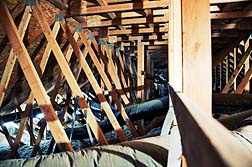Health Effects of Asbestos
www.healtheffectsofasbestos.com
Zonolite Attic Insulation and Asbestos Mesothelioma
January 14, 2009 Zonolite insulation was sold extensively throughout the US and Canada from the 1920s to the late 1970s. In fact, documents from the Environmental Protection Agency (EPA), suggest that between 15 and 35 million businesses and homes in the US were insulated with the lethally toxic substance. In Canada, the federal government included Zonolite Attic Insulation as part of the Canadian Home Insulation Program (CHIP), and the program provided homeowner grants between 1977 and the mid 1980s to promote home insulation.
Zonolite insulation was sold extensively throughout the US and Canada from the 1920s to the late 1970s. In fact, documents from the Environmental Protection Agency (EPA), suggest that between 15 and 35 million businesses and homes in the US were insulated with the lethally toxic substance. In Canada, the federal government included Zonolite Attic Insulation as part of the Canadian Home Insulation Program (CHIP), and the program provided homeowner grants between 1977 and the mid 1980s to promote home insulation.The main ingredient in Zonolite Attic insulation was vermiculite ore from the Libby Mine in Montana. The vermiculite was naturally contaminated with tremolite asbestos, a form of asbestos that experts suggest is 10 times more carcinogenic than the more prevalent chrysotile asbestos.
WR Grace bought the mine from the Zonolite Company in 1963. Estimates suggest that between a third and one half of all the vermiculite from the Libby Montana mine was sold as Zonolite attic insulation from the 1940s through to 1984, when WR Grace stopped selling the insulation.
Vermiculite- The Miracle Mineral
The Libby mine in Montana provided more than 70 percent of the world's vermiculite. Vermiculite was called the miracle mineral because it expanded when heated – making it perfect for insulation. But it was also used for potting soil, and fireproofing. To say it was a popular product would be an understatement.
But, you know that old adage – 'if it seems too good to be true, it probably is'? Well, the problems began to surface in the 1960s. Zonolite mined at Libby was also shipped north of the border to processing plants in Ontario, Winnipeg, Regina, Edmonton, Calgary, and Vancouver. An inspection in 1964 of a Zonolite plant in Calgary, Alberta, revealed high levels of dust in the air. The inspector noted that workers were not wearing any protective respiratory gear, and that 7 out of 9 workers had respiratory problems. There were 60 main processing plants in Canada and the US combined.
If it Sounds Too Good to be True
And things were just as bad, if not worse for the Libby Mine mill workers. Workers said the air was cloudy and thick with airborne particles. And even though they were given masks to use, they clogged up within minutes, making them impossible for the workers to breathe through.
The health problems weren't limited to people who worked at the mine or the processing plants. The mill at Libby reportedly spewed out more than 2 tons of asbestos every day. Not surprisingly, people who lived near the mine were also affected, with particulate making its way into the town of Libby, causing an epidemic of lung disease among the residents.
The Libby Montana mine was condemned, then closed in 1990, too late for hundreds of people who had worked at the mine and the plants, and who died before their time because of asbestos related disease.
Consequently, WR Grace hit with numerous class action lawsuits. This recent settlement of $140 million is for Canadians and Americans who used Zonolite insulation in their homes. To find out more read WR Grace Reaches $140 Million Settlement in Zonolite Insulation Class Action
For people who have asbestos mesothelioma from working with vermiculite, Zonolite Attic Insulation, or any type of asbestos for that matter, seeking the advice of an asbestos mesothelioma lawyer is one way to determine what avenues of assistance are open to you.